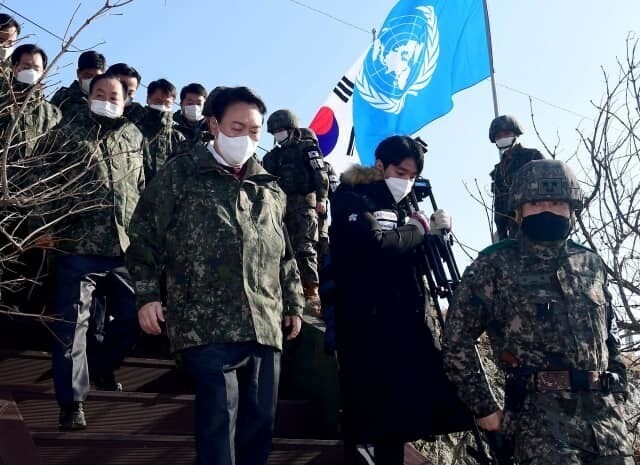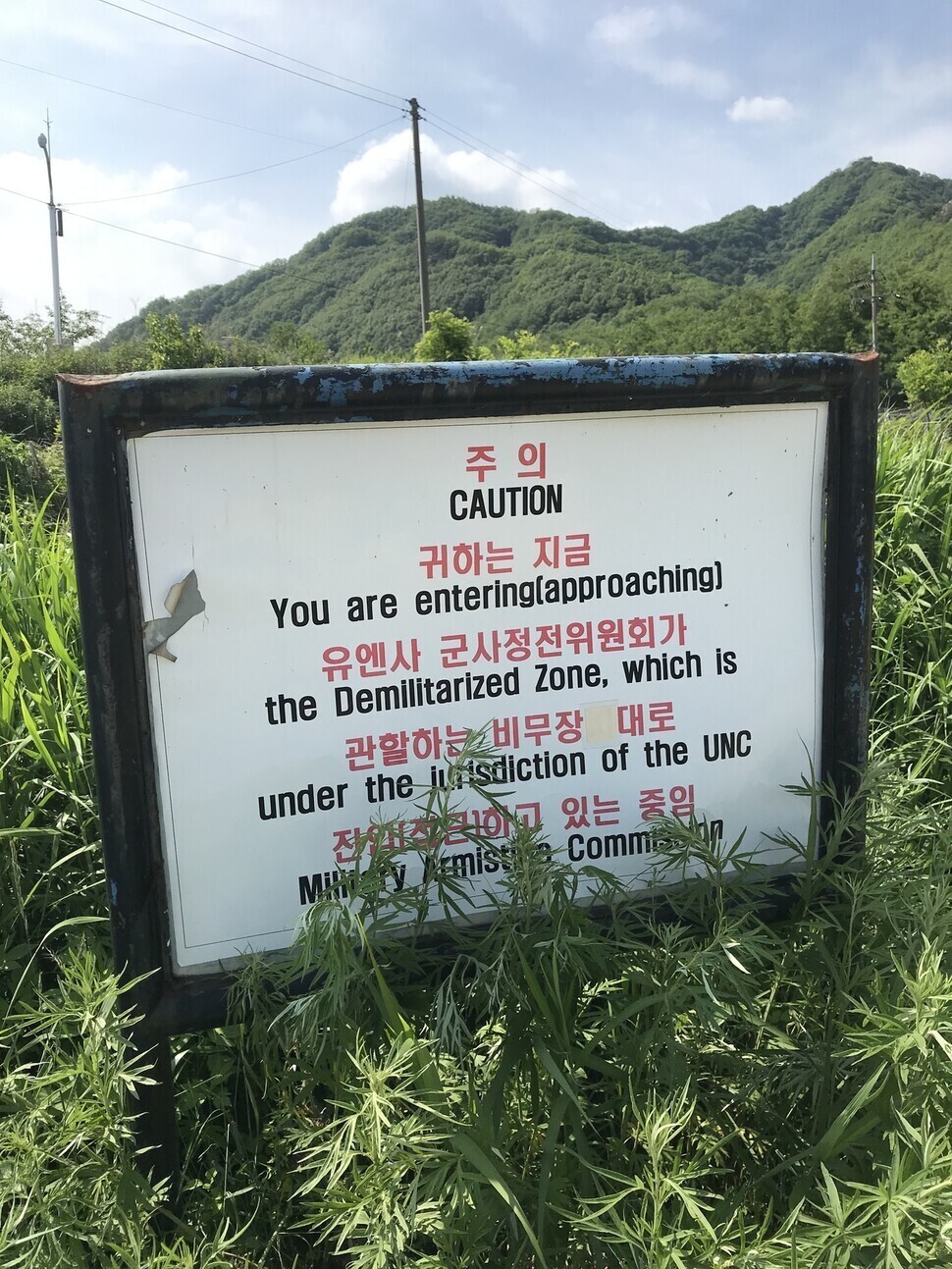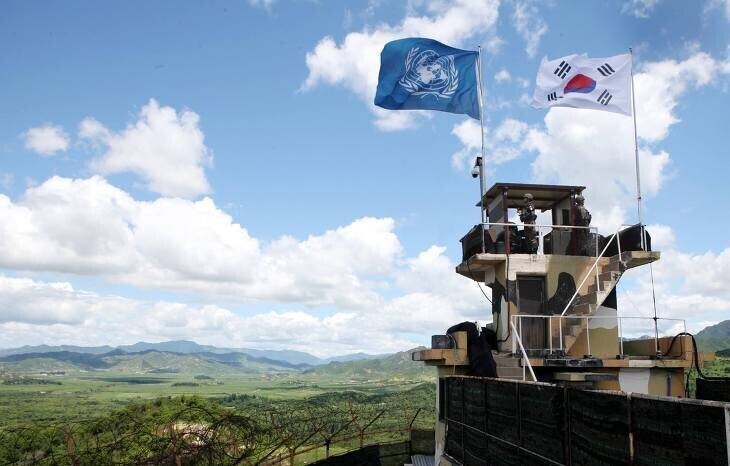hankyoreh
Links to other country sites 다른 나라 사이트 링크
[News analysis] Why the UN Command took issue with Yoon’s attire during his DMZ visit

The United Nations Command (UNC) sparked controversy recently with its response to People Power Party (PPP) presidential nominee Yoon Suk-yeol’s visit to the Demilitarized Zone (DMZ) in military uniform, which it characterized as a “violation of the Armistice Agreement.”
On Dec. 21, the UNC published a press release on its website declaring that it intended to investigate the incident to ensure that similar violations of the Armistice Agreement do not happen again. But after the response triggered controversy, the release was deleted the following day.
On Dec. 20, Yoon visited an observation post of the 3rd Infantry Division, also known as the Baekgol Unit, which operates on the front lines in Cheorwon, Gangwon Province. At the time, the presidential nominee was in a combat uniform from the waist up and donned a military police armband.
The UNC said it was a violation of the Armistice Agreement for the civilian Yoon to dress in military uniform. It explained that only combatants are allowed to wear specific indicators such as camouflage and military police armbands, adding that giving a military uniform to a civilian had exposed him to danger.
But Yoon is not the first politician to visit the DMZ in uniform. That fact is the reason so many observers are questioning why the UNC took issue with Yoon’s dress in particular.
The UNC said that it had no specific intentions in issuing the press release, explaining that it was intended to provide a response to questions from the press.
According to the UNC, after the first media report, on Dec. 21, sparked a flurry of inquiries from reporters, the command responded via a press release on its website and Facebook as part of its standard public information activities. It also said it had issued official notifications on the violation of rules when other civilians had visited the DMZ in combat uniform in the past.
But many of the reporters who cover the Ministry of National Defense and the UNC said they had only found out about the situation from reading the press release on the command’s website. It’s also uncommon for the UNC to respond to questions from reporters by posting a reply on Facebook and its website.
Some analysts suggested that the UNC’s press release was an expression of pent-up frustration over the South Korean military’s failure to amend the situation despite issues having repeatedly been raised in the past.

In its press release, the UNC quoted in detail from Article 1, paragraph 10, of the Armistice Agreement, which stresses that the UNC commander-in-chief is responsible for civil administration and relief in the area south of the DMZ and controls all access to the DMZ by soldiers and civilians. The observation post that Yoon visited is located inside the DMZ to the north of the Southern Limit Line, which places it under UNC jurisdiction.
The Armistice Agreement defines the DMZ as being 4 kilometers across — 2 kilometers each to the north and south of the Military Demarcation Line (MDL, also known as the Armistice Line) — with the Southern Limit Line located 2 kilometers to the sound of the MDL.
According to the agreement, both sides are supposed to demilitarize in the DMZ. But soon after the agreement was reached, South and North Korea began competing to establish fortifications, positions, and observation posts to station armed soldiers.
Some observers suggested the UNC’s aim wasn’t simply to affirm its jurisdiction over the DMZ, but to throw some of its weight around.
First established in Tokyo in July 1950, shortly after the Korean War broke out, the UNC relocated in July 1957 to Yongsan Garrison in Seoul, where it has remained ever since. As one of the parties in the Korean War and signatories of the Armistice Agreement, the command holds legal standing in terms of implementation of the agreement.
The UN Commander serves simultaneously as commander of US Forces Korea. US Army Gen. Paul J. LaCamera additionally serves as commander of the ROK-US Combined Forces Command — alternating among his three commander “hats” depending on the situation.
In addition to the commander, many other aides also have concurrent roles within the UNC, CFC, and USFK Command. Apart from the UNC Security Battalion — the Joint Security Area security unit at Panmunjom — and the honor guard, the UNC has effectively no actual troops.

The US would like to expand the UNC’s duties from administering the Armistice Agreement into the more general management of crisis situations on the Korean Peninsula. Since 2014, it has been steadily expanding the command’s organization, staffing and roles through a revitalization program. As a result, the number of UNC personnel has roughly doubled or tripled from its previous level of 30 to 40.
It appoints another US general to serve as UNC chief of staff — a position previously held concurrently by the USFK chief of staff — while a three-star general from Canada, Australia, or the UK serves as deputy commander, a position previously held by a member of the US military.
The UNC’s independent operation role has been stepped up, including its development into a multinational military organization. Some observers are concerned that the US might be laying the groundwork to use the UNC as a means of controlling the South Korean military once wartime operational control, or OPCON, has been transferred back to it.
The concerns have led in turn to questions over whether the real face of the UNC is using the DMZ jurisdiction issue as a way of controlling or adjusting South Korean activities with regard to inter-Korean exchange and cooperation and military trust-building, which became more frequent in the wake of three inter-Korean summits in 2018.
Some are insisting that the UNC has been serving as a way for the US to interfere in and slow the pace of progress in inter-Korean relations. The concerns have only grown louder in the wake of actual cases where the UNC’s jurisdiction over the DMZ has come into conflict with South Korea’s sovereignty.
Previously, controversy erupted in connection with the removal of DMZ monitoring guard posts (GP) and the pursuit of an inter-Korean railway and road linkage effort as agreed upon in the Pyongyang Joint Declaration of September 2018. The UNC insisted that the guard post withdrawal issue was subject to a determination by the command itself.
In August 2018, the South Korean government applied for permission to pass through the MDL to conduct a survey of the Gyeongui (Seoul-Sinuiju) railway line in North Korea, but was denied permission. This caused an immediate hurdle for the Gyeongui and Donghae (East Sea) railway modernization effort, which had been a key agreement at the inter-Korean summit on April 27 of that year.
A similar situation had unfolded with South and North Korea’s pursuit of a Gyeongui and Donghae railway linkage project in the wake of their declaration of June 15, 2000. In that case, as well, the UNC forced the South Korean government to slow down by demanding that it complete DMZ entry approval procedures.

In August 2019, South Korea’s then-Minister of Unification Kim Yeon-chul wanted to visit the village of Daeseong, South Korea’s only civilian residential community in the DMZ. He ended up giving up on the visit after the UNC refused to allow members of the press to accompany him.
In June 2019, a visiting German government delegation wanted to visit the preserved guard post No. 829 in Goseong, Gangwon Province. The event ended up canceled after the UNC refused to grant permission to pass through the DMZ, citing safety concerns.
Today, South Korean sovereignty has no bearing on the DMZ. Without permission from the UNC, not even the South Korean president, minister of national defense, or the chairman of the Joint Chiefs of Staff can enter the DMZ.
Experts have suggested the need to work actively to establish a system where the South Korean Joint Chiefs of Staff take over all or part of the jurisdiction over the DMZ.
Since 2019, the South Korean government has been in discussions with the UNC aimed at separating DMZ visits into those for military and non-military purposes in order to simplify the issue of entry permission for non-military visits. In response, the UNC has reportedly countered that South Korea has frequently failed to observe procedures for entering the DMZ.
Along those lines, some observers are viewing the flak over Yoon Suk-yeol’s uniformed visit as part of a battle of wills between South Korea and the US military under its UNC guise.
By Kwon Hyuk-chul, staff reporter
Please direct questions or comments to [english@hani.co.kr]

Editorial・opinion
![[Guest essay] The real reason Korea’s new right wants to dub Rhee a founding father [Guest essay] The real reason Korea’s new right wants to dub Rhee a founding father](https://flexible.img.hani.co.kr/flexible/normal/500/300/imgdb/original/2024/0423/8317138574257878.jpg) [Guest essay] The real reason Korea’s new right wants to dub Rhee a founding father
[Guest essay] The real reason Korea’s new right wants to dub Rhee a founding father![[Column] ‘Choson’: Is it time we start referring to N. Korea in its own terms? [Column] ‘Choson’: Is it time we start referring to N. Korea in its own terms?](https://flexible.img.hani.co.kr/flexible/normal/500/300/imgdb/original/2024/0423/3617138579390322.jpg) [Column] ‘Choson’: Is it time we start referring to N. Korea in its own terms?
[Column] ‘Choson’: Is it time we start referring to N. Korea in its own terms?- [Editorial] Japan’s rewriting of history with Korea has gone too far
- [Column] The president’s questionable capacity for dialogue
- [Column] Are chaebol firms just pizza pies for families to divvy up as they please?
- [Column] Has Korea, too, crossed the Rubicon on China?
- [Correspondent’s column] In Japan’s alliance with US, echoes of its past alliances with UK
- [Editorial] Does Yoon think the Korean public is wrong?
- [Editorial] As it bolsters its alliance with US, Japan must be accountable for past
- [Guest essay] Amending the Constitution is Yoon’s key to leaving office in public’s good graces
Most viewed articles
- 1[Guest essay] The real reason Korea’s new right wants to dub Rhee a founding father
- 2Why Korea shouldn’t welcome Japan’s newly beefed up defense cooperation with US
- 3Terry Anderson, AP reporter who informed world of massacre in Gwangju, dies at 76
- 4[Column] ‘Choson’: Is it time we start referring to N. Korea in its own terms?
- 5[Column] The clock is ticking for Korea’s first lady
- 6Opposition calls Yoon’s chief of staff appointment a ‘slap in the face’
- 7Senior doctors cut hours, prepare to resign as government refuses to scrap medical reform plan
- 8New AI-based translation tools make their way into everyday life in Korea
- 9[Editorial] Japan’s rewriting of history with Korea has gone too far
- 10[Column] Are chaebol firms just pizza pies for families to divvy up as they please?